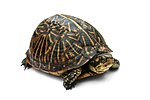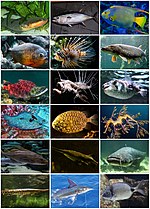Amniotes are tetrapod vertebrate animals belonging to the clade Amniota, a large group that comprises the vast majority of living terrestrial and semiaquatic...
46 KB (3,673 words) - 17:22, 17 November 2024
Reptiliomorpha (section Origin of amniotes)
Pan-Amniota) is a clade containing the amniotes and those tetrapods that share a more recent common ancestor with amniotes than with living amphibians (lissamphibians)...
28 KB (2,971 words) - 19:19, 21 September 2024
(/tɛˈtræpədə/). Tetrapods include all extant and extinct amphibians and amniotes, with the latter in turn evolving into two major clades, the sauropsids...
104 KB (10,592 words) - 10:59, 26 October 2024
Sauropsida (category Amniotes)
Sauropsida (Greek for "lizard faces") is a clade of amniotes, broadly equivalent to the class Reptilia, though typically used in a broader sense to also...
31 KB (2,818 words) - 10:10, 31 October 2024
Egg (section Amniote eggs and embryos)
Like amphibians, amniotes are air-breathing vertebrates, but they have complex eggs or embryos, including an amniotic membrane. Amniotes include reptiles...
42 KB (4,715 words) - 23:29, 22 August 2024
advanced reptiliomorphs (transitional between "amphibians" sensu lato and amniotes) positioned close to, but outside of the clade Amniota, though some recent...
12 KB (1,207 words) - 17:10, 25 March 2024
fluid is the protective liquid contained by the amniotic sac of a gravid amniote. This fluid serves as a cushion for the growing fetus, but also serves...
16 KB (1,928 words) - 21:38, 1 September 2024
Temporal fenestrae are openings in the temporal region of the skull of some amniotes, behind the orbit (eye socket). These openings have historically been used...
6 KB (609 words) - 01:51, 22 October 2024
Others prioritize the clade Sauropsida, which typically refers to all amniotes more closely related to modern reptiles than to mammals. The earliest known...
138 KB (14,853 words) - 21:00, 8 November 2024
gametes was achieved through the transition to internal fertilization. Among amniotes, the development of an erectile penis occurred independently for mammals...
42 KB (4,025 words) - 15:37, 14 November 2024
and mammals) are descended from one branch of reptiliomorphs, the amniotes. Amniotes achieved dominance, while all other reptiliomorphs and most batrachomorphs...
8 KB (897 words) - 13:37, 1 May 2024
conditions. Amniotes, however, prospered due to specific key adaptations. One of the greatest evolutionary innovations of the Carboniferous was the amniote egg...
14 KB (1,153 words) - 18:32, 11 November 2024
The primitive streak is a structure that forms in the early embryo in amniotes. In amphibians, the equivalent structure is the blastopore. During early...
23 KB (2,803 words) - 06:48, 25 October 2024
Serpentes (/sɜːrˈpɛntiːz/). Like all other squamates, snakes are ectothermic, amniote vertebrates covered in overlapping scales. Many species of snakes have...
152 KB (15,151 words) - 10:28, 5 November 2024
Carboniferous.[citation needed] Amniotes branched from amphibious tetrapods early in the Carboniferous period. The synapsid amniotes were dominant during the...
78 KB (7,078 words) - 09:49, 17 November 2024
animal groups that have adapted to life in dry environments; the other is amniotes, whose living members are reptiles, birds and mammals. Both the smallest...
131 KB (12,547 words) - 07:40, 15 November 2024
snake in the Harry Potter series Nagini mazonense, an extinct species of amniote Nagin (disambiguation) Nagina (disambiguation) Naga (disambiguation) Ichchadhari...
782 bytes (130 words) - 04:03, 15 July 2024
amphibians to evolve into amniotes that had adaptations that allowed them to live farther away from water bodies. These amniotes began to evolve both carnivory...
20 KB (2,004 words) - 20:09, 3 November 2024
islands and, in the case of sea turtles, much of the ocean. Like other amniotes (reptiles, birds, and mammals) they breathe air and do not lay eggs underwater...
126 KB (13,170 words) - 11:51, 17 November 2024
Mammal (section Evolution from older amniotes)
water in. Hence, amniotes can lay eggs on dry land, while amphibians generally need to lay their eggs in water. The first amniotes apparently arose in...
222 KB (23,157 words) - 21:11, 12 November 2024
advanced labyrinthodonts. The oldest known animal that may have been an amniote, a reptile rather than an amphibian, is Casineria (though it has also been...
30 KB (3,190 words) - 14:03, 10 September 2024
sense, it is a paraphyletic group encompassing all tetrapods excluding the amniotes (tetrapods with an amniotic membrane, such as modern reptiles, birds and...
161 KB (18,019 words) - 19:28, 2 October 2024
the only group that survived into the Cenozoic are mammals. Unlike other amniotes, synapsids have a single temporal fenestra, an opening low in the skull...
57 KB (5,746 words) - 10:39, 23 October 2024
PMID 23653398. Laurin, M.; Reisz, R.R. (1995). "A reevaluation of early amniote phylogeny". Zoological Journal of the Linnean Society. 113 (2): 165–223...
49 KB (3,811 words) - 05:55, 16 November 2024
had become very rare. Most of the Reptiliomorpha, stem-amniotes that gave rise to the amniotes, disappeared in the Triassic, but two water-dwelling groups...
71 KB (7,725 words) - 08:11, 12 November 2024
outermost fetal membrane around the embryo in mammals, birds and reptiles (amniotes). It is also present around the embryo of other animals, like insects and...
11 KB (1,247 words) - 14:45, 3 November 2024
respiratory transition at birth or hatching in viviparous and oviparous amniote vertebrates". Comparative Biochemistry and Physiology. Part A, Molecular...
15 KB (1,633 words) - 00:34, 15 November 2024
which became dominant land vertebrates, as well as the first appearance of amniotes including synapsids (the clade to which modern mammals belong) and sauropsids...
115 KB (12,087 words) - 12:23, 15 November 2024
were amniotes, which developed in eggs with internal membranes which allowed the developing embryo to breathe but kept water in. The first amniotes arose...
40 KB (4,283 words) - 02:40, 12 November 2024





























